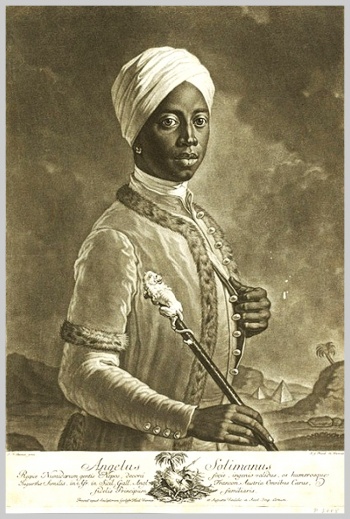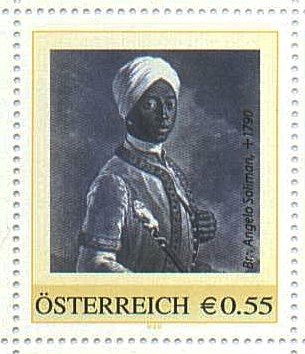En: Angelo Soliman
Inhaltsverzeichnis
Angelo Soliman
Angelo Soliman (born Mmadi Make c. 1721, probably in present-day northeastern Nigeria/northern Cameroon; he died on November 21, 1796, in Vienna). Travelled to Europe, and achieved prominence in Viennese society and Freemasonry.
Life
Angelo Soliman probably belonged to the Kanuri ethnic group. His original name, Mmadi Make, is linked to a princely class in the Sokoto State in modern Nigeria. He was taken captive as a child and arrived in Marseilles as a slave, eventually transferring to the household of a marchioness in Messina who oversaw his education. Out of affection for another servant in the household, Angelina, he adopted the name Angelo and chose to celebrate September 11, his baptismal day, as his birthday. After repeated requests, he was given as a gift in 1734 to Prince Georg Christian, Prince von Lobkowitz, the imperial governor of Sicily. He became the Prince's valet and traveling companion, accompanying him on military campaigns throughout Europe and reportedly saving his life on one occasion, a pivotal event responsible for his social ascension.
After the death of Prince Lobkowitz, Soliman was taken into the Vienna household of Joseph Wenzel I, Prince of Liechtenstein, eventually rising to chief servant. Later, he became royal tutor of the heir to the Prince, Aloys I. On February 6, 1768 he married Magdalena Christiani,the widow of Harrach'schen, sister of the French general François Etienne de Kellermann (1770–1835), General of Napoleon Bonaparte, Duke of Valmy and Secretary of Anton Christiano.
A cultured man, Soliman was highly respected in the intellectual circles of Vienna and counted as a valued friend by Austrian Emperor Joseph II and Count Franz Moritz von Lacy. In 1783, he joined the Masonic lodge "True Harmony", whose membership included many of Vienna's influential artists and scholars of the time, among them the musicians Wolfgang Amadeus Mozart and Joseph Haydn as well the Hungarian poet Ferenc Kazinczy. Lodge records indicate that Soliman and Mozart met on several occasions. It is likely that the character Bassa Selim in Mozart's opera The Abduction from the Seraglio was based on Soliman.
Eventually becoming the Grand Master of that lodge, Soliman helped change its ritual to include scholarly elements. This new Masonic direction rapidly influenced Freemasonic practice throughout Europe. Soliman is still celebrated in Massonic rites as "Father of Pure Masonic Thought", with his name usually transliterated as "Angelus Solimanus".
During his lifetime Soliman was regarded as a model of the assimilation and perfectibility of Africans, but after his death he literally became a specimen of the "African race". Wigger and Klein distinguish four aspects of Soliman – the "royal Moor", the "noble Moor", the "physiognomic Moor" and the "mummified Moor".
The first two designations refer to the years prior to his death. The term "royal Moor" designates Soliman in the context of enslaved Moors at European courts, where their skin color marked their inferiority and they figured as status symbols betokening the power and wealth of their owners. Bereft of his ancestry and original culture, Soliman was degraded to an "exotic-oriental sign of his lord's standing" who was not allowed to live a self-determined existence. The designation "noble Moor" describes Soliman as a former court Moor whose ascent up the social ladder due to his marriage with an aristocratic woman made his emancipation possible. During this time Soliman became a member of the Freemasons and was considered almost equal to his fellow Masons, but he continued to face a thicket of race and class prejudices.
Beneath the surface appearance of integration lurked Soliman's remarkable destiny. Though he moved smoothly in high society, the exotic quality ascribed to him was never lost and over the course of his lifetime was transformed into a racial characteristic. The qualities used to categorize Soliman as a "physiognomic Moor" were set forth by pioneering Viennese ethnologists during his lifetime, framed by theories and assumptions concerning the "African race". He could not escape the taxonomic view that focused on typical racial characteristics, i.e., skin color, hair texture, lip size and nose shape. Neither his social standing nor his membership in the Freemasons could prevent his posthumous exploitation, leading to his ultimate status as the "mummified Moor".
Instead of a receiving a Christian burial, Soliman was – at the request of the director of the Imperial Natural History Collection – skinned, stuffed and made into an exhibit within this cabinet of curiosities.
Decked out in ostrich feathers and glass beads, this mummy was on display until 1806 alongside stuffed animals, transformed from a reputable member of intellectual Viennese society into an exotic specimen. By stripping Soliman of the insignia of his lifetime achievements, ethnologists instrumentalized him as what they imagined to be an exemplary African "savage". Soliman's daughter Josefine sought to have his remains returned to the family, but her petitions were in vain. During the October revolution of 1848, the mummy burned. A plaster cast of Soliman's head made shortly after his death of a stroke in 1796 is still on display in the Rollett Museum in Baden. His grandson is Ernst, Baron von Feuchtersleben.
Sources
- http://www.joshuaproject.net/people-profile.php?rog3=CM&rop3=104605
- http://encyclopedia2.thefreedictionary.com/Kanuri+people
- http://www.afrikanistik.at/personen/soliman_angelo.htm
- Geschichte der Afrikanistik in Österreich: Angelo Soliman (English Translation)
- Angelo Soliman und seine Freunde im Adel und in der geistigen Elite (in German)
- Wilhelm. A. Bauer, A. Soliman, Hochfürstlische Der Mohr, W. Sauer (Hg), 1922
- Virtuelles Learning Center | Mozarthaus Vienna
- Steele, Tom (2007). Knowledge Is Power! The Rise and Fall of European Popular Educational Movements, 1848–1939. Peter Lang. p. 315. ISBN 978-3-03910-563-2.
- Moore, Keith; 32, Keith Moore (2008). Freemasonry, Greek Philosophy, the Prince Hall Fraternity and the Egyptian (African) World Connection. AuthorHouse. ISBN 9781438909059.
- Iris Wigger, Katrin Klein (2009). "Bruder Mohr". Angelo Soliman und der Rassismus der Aufklärung. In: Entfremdete Körper. Rassismus als Leichenschändung. Ed. Wulf D. Hund. Bielefeld: Transcript. pp. 81–115. ISBN 978-3-8376-1151-9.
- http://angelosoliman.blogspot.com/
- http://www.tanzhotel.at/Deutsch/Angelo_Soliman/Firla.htm
- Seipel, W. (1996). Mummies and Ethics in the Museum. In: Human Mummies. Ed. Konrad Spindler et al. Vienna: Springer. pp. 3–7. ISBN 3-211-82659-9. These circumstances are omitted in the early biographical notes by the Abbé Henri Grégoire – for an English translation see: Biographical Account of the Negro Angelo Soliman. In: The Monthly Repository, Vol. XI, No. CXXVII, 1816, pp. 373 - 376 .
- Wilhelm. A. Bauer, A. Soliman, Hochfürstlische Der Mohr, W. Sauer (Hg), 1922
Links


